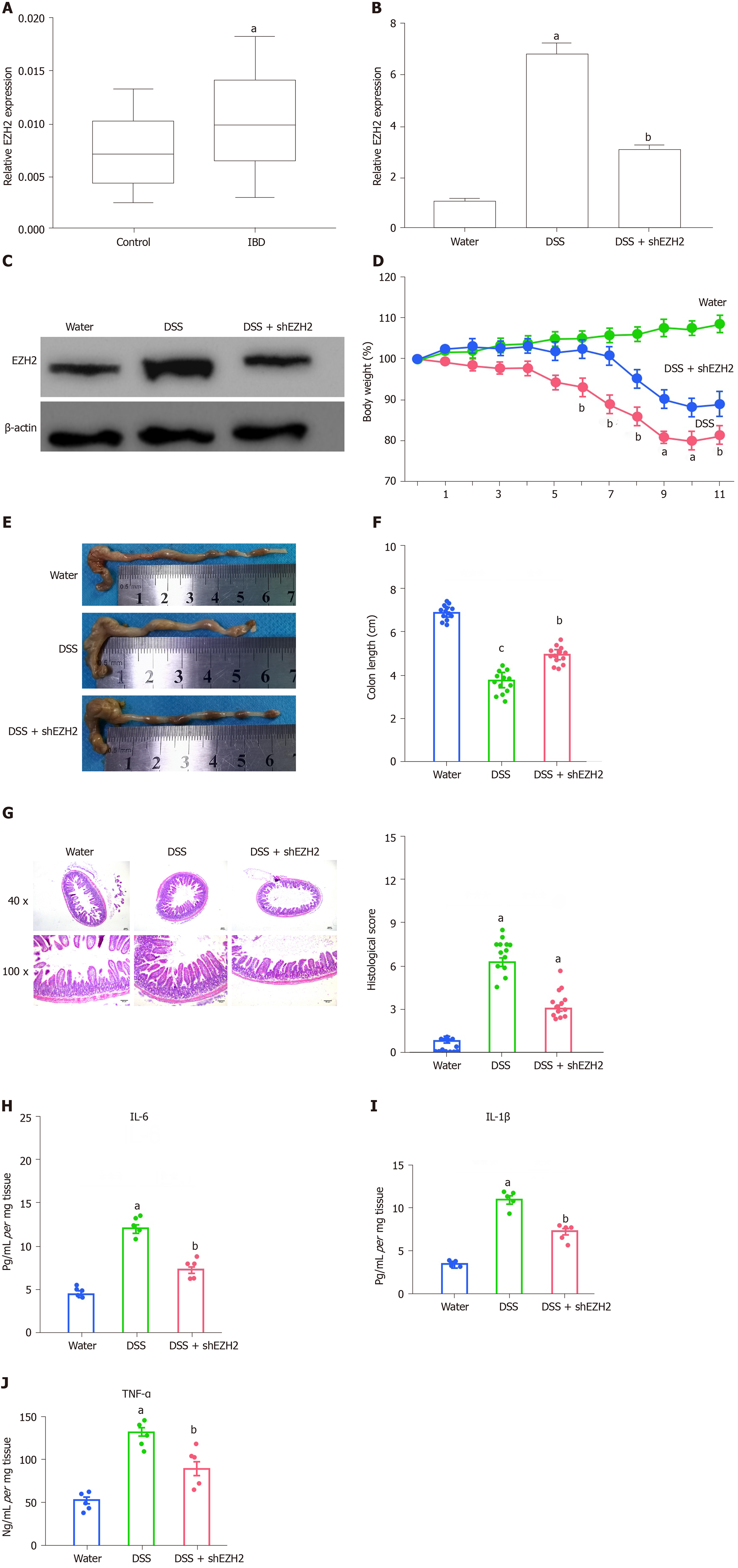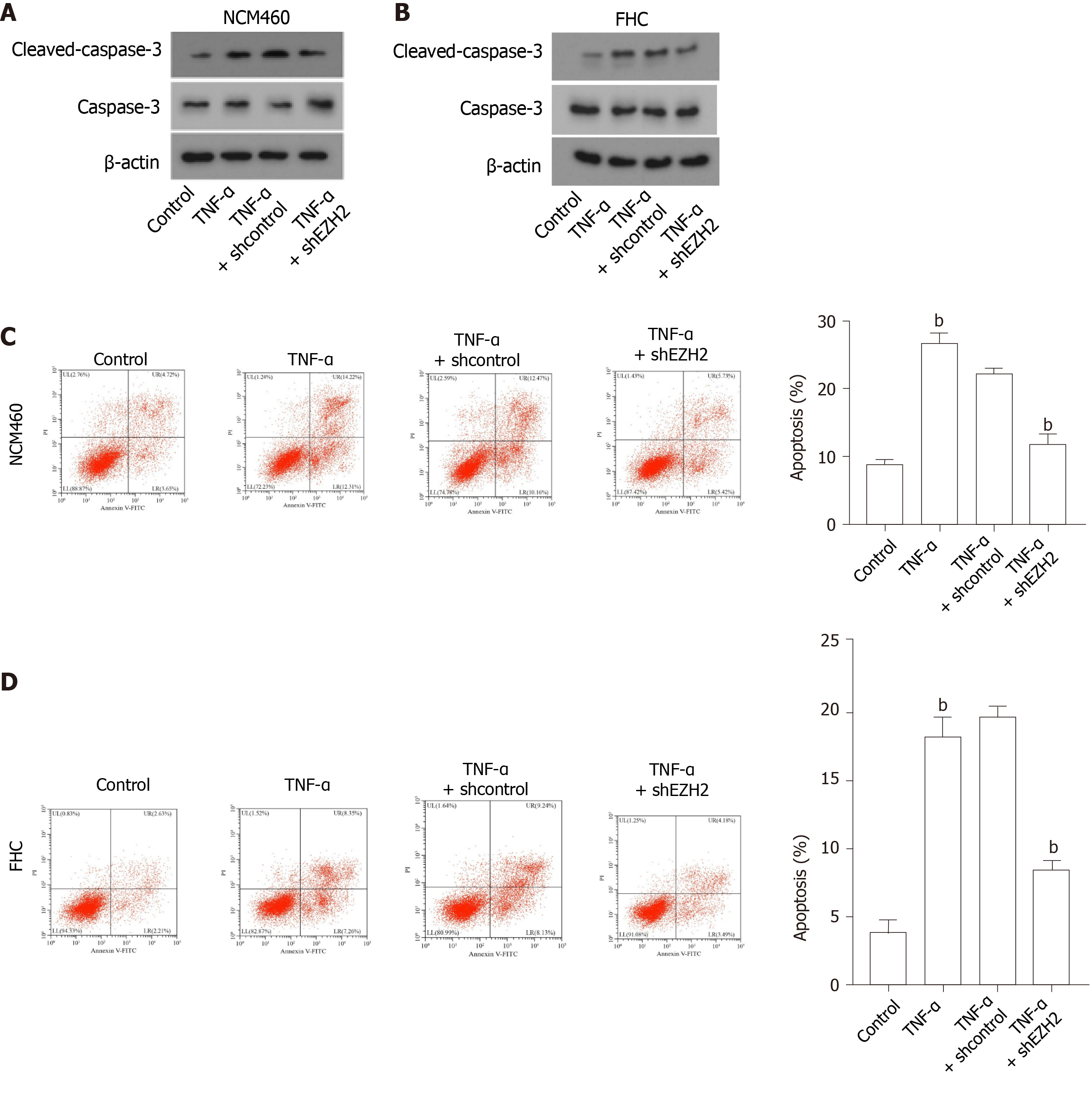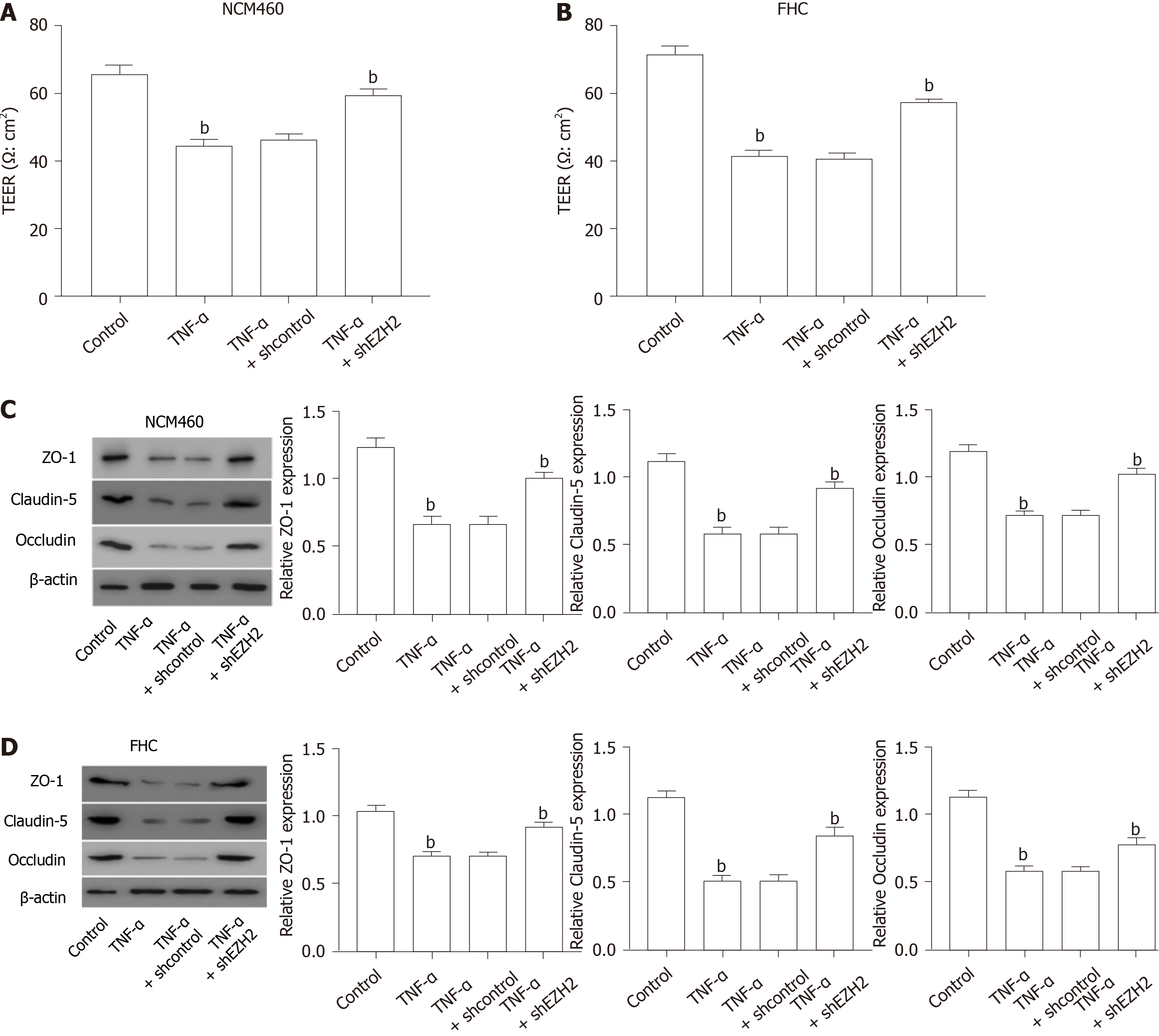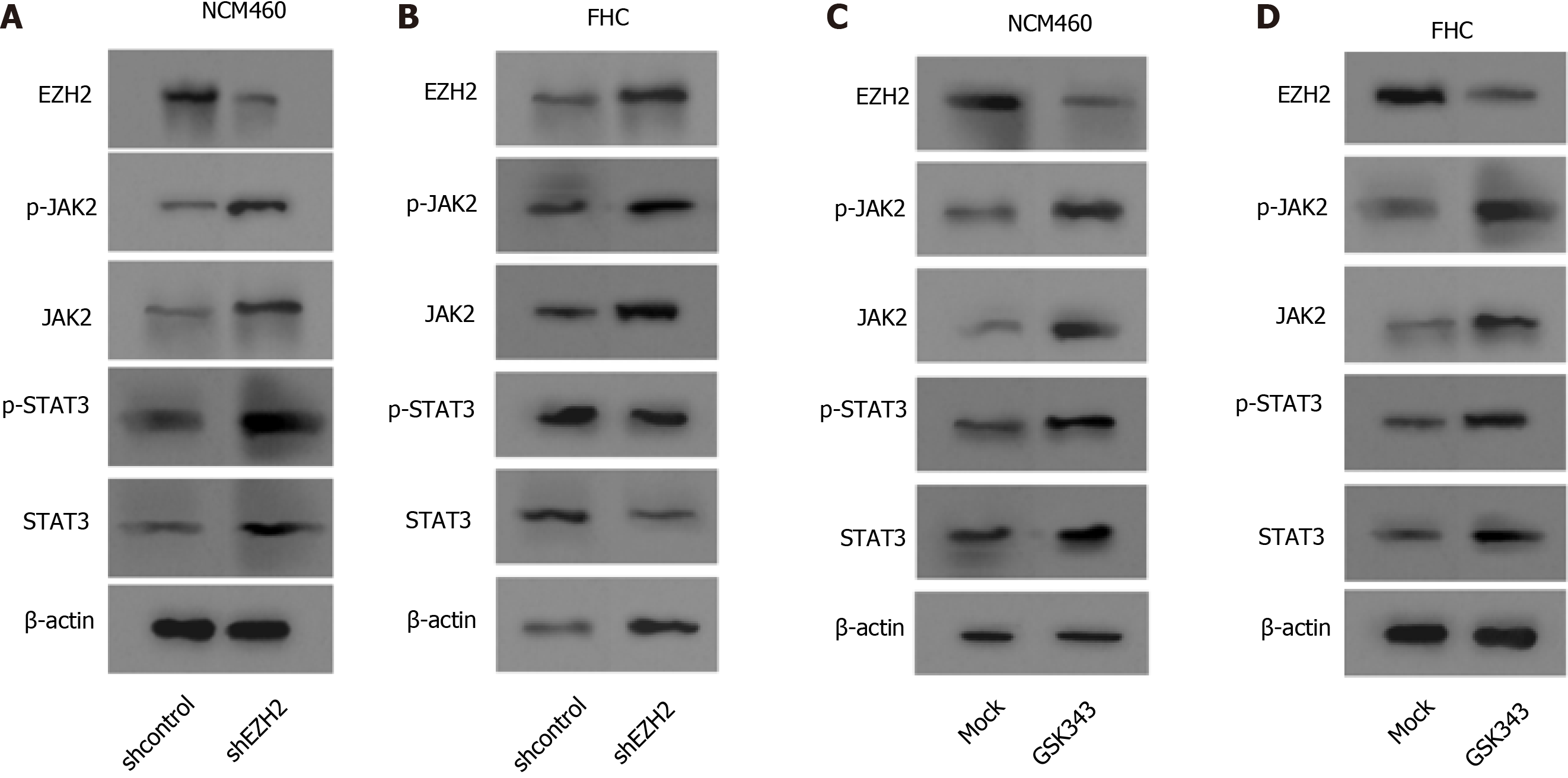Copyright
©The Author(s) 2021.
World J Gastroenterol. Jun 14, 2021; 27(22): 3073-3084
Published online Jun 14, 2021. doi: 10.3748/wjg.v27.i22.3073
Published online Jun 14, 2021. doi: 10.3748/wjg.v27.i22.3073
Figure 1 The depletion of enhancer of zeste homolog 2 inhibits dextran sodium sulfate-induced colitis in vivo.
A: The expression of enhancer of zeste homolog 2 (EZH2) was measured by quantitative real-time polymerase chain reaction in clinical inflammatory bowel disease (IBD) samples (n = 50) and healthy controls (n = 50); B-J: The IBD mouse model was conducted by adding dextran sodium sulfate (DSS). The mice were intraperitoneally injected with lentiviral plasmids carrying EZH2 shRNA; B: The expression of EZH2 was detected by quantitative real-time polymerase chain reaction in the mice; C: The protein levels of EZH2 were analyzed by Western blot in the mice; D: The body weight in the mice; E and F: Colon length of the mice; G: representative hematoxylin and eosin staining of distal colon sections; H-J: Colonic inflammatory cytokines in the mice. n = 10, mean ± SD. aP < 0.05; bP < 0.01; cP < 0.001. TNF-α: Tumor necrosis factor-α; IL: Interleukin.
Figure 2 Enhancer of zeste homolog 2 depletion attenuates apoptosis of colonic epithelial cells.
The NCM460 and fetal human colon (FHC) cells were treated with tumor necrosis factor-α (TNF-α), or co-treated with TNF-α and enhancer of zeste homolog 2 (EZH2) short hairpin RNA. A and B: Western blot analysis of the caspase3 and cleaved-caspase3 expression; C and D: Flow cytometry analysis of the cell apoptosis. n = 3, mean ± SD, bP < 0.01.
Figure 3 The depletion of enhancer of zeste homolog 2 attenuates permeability of colonic epithelial cells.
The NCM460 and fetal human colon (FHC) cells were treated with tumor necrosis factor-α (TNF-α), or co-treated with TNF-α and enhancer of zeste homolog 2 (EZH2) short hairpin RNA. A and B: Transepithelial electrical resistance (TEER) measurement of the transepithelial electrical resistance levels; C and D: Western blot analysis of the Zona occludens 1 (ZO-1), claudin-5, and occludin expression. n = 3, mean ± SD, bP < 0.01.
Figure 4 Enhancer of zeste homolog 2 inactivates janus kinase 2/ signal transducer and activator of transcription signaling in colonic epithelial cells.
A and B: The NCM460 and fetal human colon (FHC) cells were treated with control shRNA or enhancer of zeste homolog 2 (EZH2) short hairpin RNA. Western blot analysis of the Janus kinase 2 (JAK2), Signal transducer and activator of transcription 3 (STAT3), and EZH2 expression and JAK2 and STAT3 phosphorylation; C and D: The NCM460 and FHC cells were treated with GSK343 (5 μM). Western blot analysis of the JAK2, STAT3, and EZH2 expression and JAK2 and STAT3 phosphorylation. n = 3.
Figure 5 Enhancer of zeste homolog 2 inactivates janus kinase 2 expression by regulating histone H3K27me3.
A-E: The NCM460 and fetal human colon (FHC) cells were treated with control short hairpin RNA or enhancer of zeste homolog 2 (EZH2) short hairpin RNA; A and B: Western blot analysis of the H3K27me3, Janus kinase 2 (JAK2), signal transducer and activator of transcription 3 (STAT3), and EZH2 expression and JAK2 and STAT3 phosphorylation; C and D: Chromatin immunoprecipitation (ChIP) assays of the JAK2 promoter using H3K27me3 antibody; E and F: The quantitative real-time polymerase chain reaction assays of JAK2 messenger RNA expression. n = 3, mean ± SD, bP < 0.01.
Figure 6 Enhancer of zeste homolog 2 promotes apoptosis and permeability by inactivating janus kinase 2/ signal transducer and activator of transcription signaling in colonic epithelial cells.
The tumor necrosis factor-α (TNF-α)-treated NCM460 and fetal human colon (FHC) cells were treated with GSK343 (5 μM) or co-treated with GSK343 (5 μM) and TG101348 (5 μM). A and B: Flow cytometry analysis of the cell apoptosis; C and D: Western blot analysis of the Zona occludens 1 (ZO-1), claudin-5, and occludin expression. n = 3, mean ± SD. bP < 0.01.
- Citation: Zhou J, Yang Y, Wang YL, Zhao Y, Ye WJ, Deng SY, Lang JY, Lu S. Enhancer of zeste homolog 2 contributes to apoptosis by inactivating janus kinase 2/ signal transducer and activator of transcription signaling in inflammatory bowel disease. World J Gastroenterol 2021; 27(22): 3073-3084
- URL: https://www.wjgnet.com/1007-9327/full/v27/i22/3073.htm
- DOI: https://dx.doi.org/10.3748/wjg.v27.i22.3073














